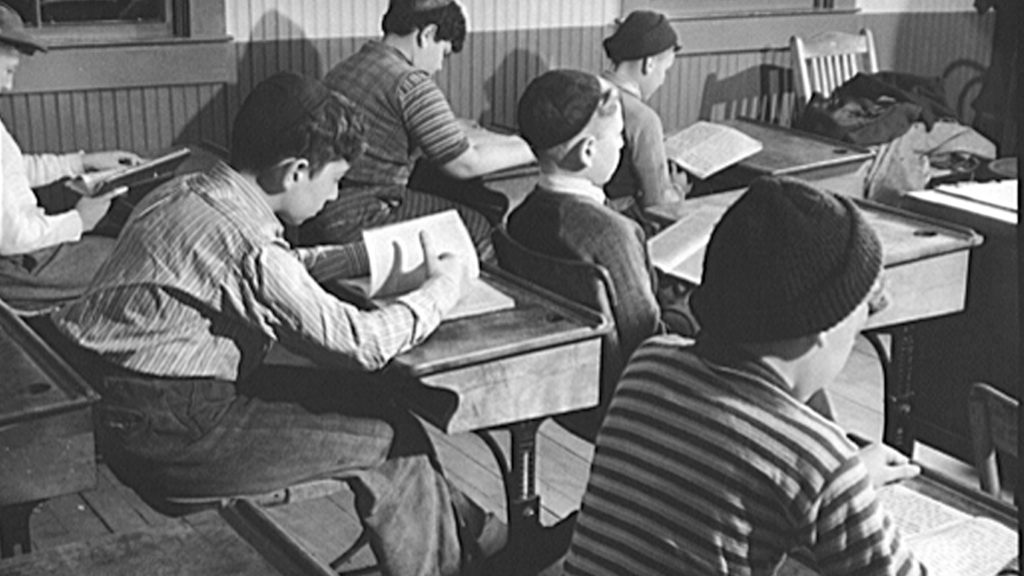Godly Guardrails and Secular Assumptions
In his 1968 classic, Life in Classrooms, education scholar Philip W. Jackson observed that “the crowds, the praise, and the power that combine to give a distinctive flavor to classroom life collectively form a hidden curriculum which each student (and teacher) must master if he is to make his way satisfactorily through the school.” Mastering this hidden curriculum involved complying with the procedural expectations of the institution by doing things like completing homework (even if incorrectly) or reading quietly during a free period (even if few pages were turned).
Nothing much about the American hidden curriculum has changed in the half century or so since Jackson’s book was released, which, depending on your perspective, is either dismaying or a refreshing change of pace. Students are still rewarded for handing in work on time and writing neatly. They’re still punished for talking back or showing up visibly hungover. And mastery of the hidden curriculum is still recognized with higher grades in the formal curriculum, not to speak of letters of recommendation (the model student’s prize for being the kind of kid who makes a teacher’s life easier).
The hidden curriculum—and the kinds of students who excel at it—are at the heart of Ilana M. Horwitz’s recent book, God, Grades, and Graduation: Religion’s Surprising Impact on Academic Success. Horwitz uses qualitative and quantitative methods to argue that because religion and public schooling are complementary institutions that aim to inculcate similar values, religious teens have an advantage when it comes to educational achievement. This advantage—which takes the form of conscientious and cooperative behavior, access to social connections and opportunities, and “godly guardrails” against risky behavior—enables them to achieve higher grades in high school and complete more years of education than their nonreligious peers. This conclusion may not be surprising, but Horwitz’s argument for it is thorough and convincing.
In the less impressive second half of her book, Horwitz discusses her other, “paradoxical” finding: that the same intense religiosity that boosts educational achievement across all socioeconomic groups also lowers academic ambition among some, making more affluent religious teens likely to attend less-selective colleges.
Let’s begin with one of Horwitz’s interviewees, a boy named Jacob. He is a white, working-class teen from Pennsylvania. He is also a deeply religious Catholic (Horwitz calls such students “abiders”). Jacob is on the school football team, and his friends party regularly. But though he feels peer pressure, he mostly refrains from doing “immoral things” like drinking or taking drugs. “I could get drunk every day of my life. That’s how easy it is to get beer and to get weed,” he says. Jacob is a conscientious student, gets good grades, and displays what teachers might call a good attitude (“I figure if I’m going to sit through class for 8 hours I might as well make the best of it.”) And it pays off: he becomes the first in his family to earn a bachelor’s degree, then goes on to attend medical school and becomes a surgeon.
Horwitz argues that Jacob’s academic and career success can be attributed—at least in part—to being raised with what she calls “religious restraint.” His conscientious and cooperative behavior, which keeps him out of trouble and helps put him on good footing with adults, “stems from his God-centered self-concept where he tries to be a good Catholic by doing ‘what Jesus would do pretty much, be a good person.’”
Plausible. But you should have your antennae up. It may be, as Horwitz at one point says, that the relative paucity of existing research on religion and educational success is due to “the liberal and secular nature of the academy (and especially sociology), which makes scholars reticent to view religion as a serious area of inquiry.” But it also may be the result of a practical concern: the effects of religiosity are hard to reliably isolate from factors like income and family structure. Jacob was not born into the ether. He has two married parents who are deeply involved in his life, siblings, and grandparents who live close by and with whom he is close. Isn’t it just as likely that it is they who keep him on the straight and narrow path to success? Hold on to that skepticism. It will make you appreciate Horwitz’s uncommonly good work here.
Much of Horwitz’s research is based on her secondary analysis of the survey and interview data from the National Study of Youth and Religion (NSYR), a longitudinal study of more than three thousand US teens led by researchers at the University of Notre Dame and the University of North Carolina at Chapel Hill. Focusing on Christian teens, Horwitz analyzed abider and nonabider NSYR teen grades using the NSYR data, and the results support the picture suggested by Jacob’s story above. Religious students are significantly more likely to report earning “all” or “mostly” As compared with their nonabider peers. In fact, she observes, the 10 percent advantage that abiders hold over nonabiders in receiving top grades is “about the same amount of academic advantage . . . as students in the top 25% of the socioeconomic distribution have over students in the bottom 25%.” Being religious helps as much as being well-off. That actually is surprising.
When Horwitz compared the grades of abiders and nonabiders within each social class, the abiders again were more likely to report top grades. And their advantage is not small—Horwitz found that working-class and middle-class abiders are 12 percent and 8 percent, respectively, more likely to earn top grades than their nonabider working- and middle-class peers.
What’s really clever, though, is the next step of her analysis. To address the very real risk that the apparent relationship between adolescent religiosity and academic achievement is spurious, Horwitz conducted another study, this one using sibling data from the National Longitudinal Study of Adolescent to Adult Health. She found that the more religious of two siblings was more likely to have better grades and higher educational aspirations, and complete more years of higher education than the less religious sibling. This isn’t definitive—sociologists don’t get to say QED very often—but it does strongly suggest that there is a causal component to the relationship between teen religiosity and high school GPA. And Horwitz’s interviews with abiders like Jacob tell a coherent story about why this should be so.
Later on in the book, Horwitz discusses the differences in educational attainment between abiders and nonabiders of different social classes, noting that the disparity is particularly pronounced in the working class, where abiders are twice as likely to achieve a bachelor’s degree as nonabiders, and the middle class, where abiders are about one and a half times more likely. This makes sense, she argues, when you consider what religion offers to working-class teens: encouragement and techniques to delay gratification, social capital, and discipline. Of course, even these advantages are not powerful enough to compensate for the challenges facing most poor teenagers, nor are they especially needed by teens from professional-class families who tend to have an abundance of social capital and generally plan to go to college regardless of their grades. But for working- and middle-class teenagers, whose paths to college are discernible but not assured, the advantages of religious restraint can make a real difference.
As is now fashionable, Horwitz’s book contains a section titled “Positionality” in the appendix. In it, she describes her upbringing as the child of highly educated immigrants who worked as janitors (they were Soviet Jewish émigrés). “In some ways,” she writes, “I could relate to the struggles of working-class kids in the book. . . . But in some respects, I also grew up with a lot of privilege and could relate to the kids in this book from the professional class.” She notes that because her upbringing was different from those of the teenagers highlighted in the book, she was “very concerned about how my personal experience would color my analysis.” But luckily, she enlisted a small army of undergraduate and graduate research assistants who “helped me overcome my own limitations in interpreting the data.” They were diverse, she tells us, by all the seemingly relevant measures:
Their religious backgrounds included Muslim, members of the Church of Jesus Christ of Latter-day Saints, Protestant, Catholic, Atheist, Buddhist, and other affiliations. Some grew up very religious and some grew up completely nonreligious. Several were first-generation and/or low-income college students, and several were students of color.
All this diversity aside, almost all of Horwitz’s research assistants shared one thing in common, which she appears not to have reflected upon—they were enrolled at Stanford University, one of the most selective schools in the country. And this, perhaps, is why none of them stopped Horwitz from making some bad mistakes. These mistakes are united by a failure to recognize that gods and pieties come in many different forms.
Consider her discussion of professional-class abiders, whom she observes tend to perform well in high school but “undermatch” in the college selection process by choosing to attend schools less selective than those they could probably have gotten into.
Horwitz introduces us to Sally, a Mormon adolescent living in Salt Lake City with her two college-educated parents. Sally gets mostly As in high school and describes her friends as “hardworking” and “fun-loving.” She avoids “people who like to do drugs or listen to hard rock” because she recognizes that “she has a temptation to follow the crowd.” Though she has good grades, she chooses to attend a local public university where she’ll have a better chance of playing in the orchestra and getting a scholarship. “The university she chooses is also a comfortable choice,” Horwitz writes. “Her sister goes there and her music teacher is a member of the faculty.”
Horwitz’s assessment of professional-class abiders is that religious restraint “recalibrates their vision of their future when it comes to choosing a university to attend” (more on that recalibration later). But it also, she argues, makes them more averse to “exploring new experiences and stepping out of one’s comfort zone.” This is, perhaps, a fair assessment of Sally. But how in the world does it apply to Gina, who is profiled in the same chapter?
Gina took a gap year before college to evangelize in South America. She lived with a host family, taught English at a bilingual school, led Spanish worship services, and hosted craft days and Bible school in local villages. When she returned, Horwitz reports, Gina was “more intent on spreading the gospel in Peruvian prisons and Haitian orphanages than hunkering down in the library.” She chose to attend a nonselective local public university, received a degree in communications, and became an international mission coordinator. This is hardly the path of someone averse to new experiences. But Horwitz never addresses the disconnect.
A similar blindness is on display in her discussion of Jewish adolescent girls (the NSYR data contained an oversample). In contrast to abider girls from professional-class families, girls raised by at least one Jewish parent were “oriented toward achieving prestigious careers as early as middle school and throughout adolescence.” They “saw themselves as making their mark in the world through high-impact, prestigious careers and even becoming prominent figures.” Unlike girls like Sally, motherhood wasn’t at the forefront of their minds.
But Horwitz is comparing apples to kumquats here. No one would expect religious Christian abiders to be similar to “adolescents raised by at least one Jewish parent” (a more appropriate comparison would have been to Orthodox Jewish teens). And the discussion raises questions about Horwitz’s ability to dispassionately interpret what she measures and observes, particularly when it comes to those children—affluent, highly educated, liberal—she seems to know best.
Religious girls, she tells us, “yearn for the comfort of the familiar.” They are “happy doing what is expected” and content to follow “the path laid out for girls” in their families and communities. But girls raised by at least one Jewish parent couldn’t be further from this, she tells us. They are ambitious, career-driven, and free-thinking and display an early focus on attending a highly selective university. Consider teenager Stacy, who wants to attend “a good college—like an Ivy League kind of college” and then law school. How adventurous! How bold! Surely this ambition of Stacy’s arose spontaneously, was freely chosen and pursued?
No, of course not: “For Stacy, the idea of becoming a lawyer came from her dad, who thought she would be a good lawyer because she likes to argue, is opinionated, and enjoys discussing politics.” Horwitz even makes this explicit in the next sentence, noting that the fathers of Jewish girls in her sample tend to encourage their daughters to pursue careers instead of prioritizing having a family, as the fathers of female abiders do.
Horwitz’s tendency to take the behavior of highly educated and largely irreligious folk of the academy and the two coasts as her baseline leads to the book’s greatest flaws. After establishing that religious commitment helps with academic success, she proceeds to discuss her paradoxical finding. Of religious abiders, she writes that their “understanding of their place in the world and the possibilities that lay ahead is also based on what they see as valued by their religious beliefs.” This is a point that Horwitz feels the need to emphasize: there really are “millions of young men and women who do not live to impress college admissions counselors. For them, it is God who matters.” Repeatedly, we are told that these students are making less ambitious choices about where to attend college than we would expect given their high school grades. But what exactly is it that she assumes we would expect? And why does only one kind of ambition count?
Throughout the book, Horwitz operates within a paradigm in which education is always good, more education is always better, and education at a selective institution is always best. (Horwitz herself holds four degrees, including a master’s from Columbia and a doctorate from Stanford). This leads to some unforced errors. For instance, she writes that “the longer we stay in school, the more we will earn and the longer we will live” and glosses over the debate surrounding the question of whether attending a selective college actually has a big effect on future earnings (research by Stacy Dale and Alan B. Krueger suggests that it mostly doesn’t). The backdrop of intellectual and cultural assumptions that Horwitz clearly shares with most of her peers blinds her to what should have been obvious without any statistical study: not every American high school student is a rational prestige maximizer when it comes to education.
While a student at Yeshiva University High School for Girls, I often heard YU president Richard Joel deliver recruitment pitches in which he’d contend that, given the option, it was better for a Jewish student to attend Yeshiva University than Harvard. Not all of us were receptive to the pitch, but some of my high-achieving Jewish abider friends were.The same goes for all the high school valedictorians who choose to attend Brigham Young University or Wheaton College or the local community college rather than the most selective college they can get into.
Religious restraint doesn’t recalibrate a teen’s ambition from some natural, preset baseline of worldly ambition; it calibrates the teen’s approach to life and its decisions. The paradox of religious restraint is not a paradox at all.
Suggested Reading
On the Separation of Yeshiva and State
What conservative activists call religious liberty is often a deliberate blurring of the separation of church and state. Orthodox Jews ought to worry more about this, even if it might mean some vouchers for day school.

Religious Freedom and Jewish Experience
Religious liberty is back on the Supreme Court’s docket. The court should think carefully about what freedom of religion really means in different communities. Take Jews for instance . . .
Conservative Judaism Is Too Important to Fail
Susan Grossman acknowledges the movement’s failings, but sees more reason for hope than despair.

The Day School Tuition Crisis: A Short History
In 1935, Israel Chipkin wrote that day schools were “financially prohibitive” for most Jews. The more things change . . .

Comments
You must log in to comment Log In